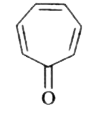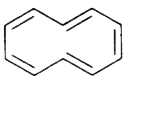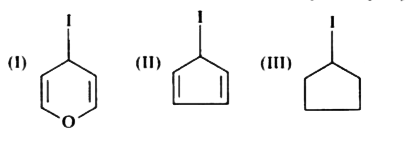The ring systems having following characteristics are aromatic.
(i) Planar ring containing conjugated π bonds.
(ii) Complete delocalization of the π-electrons in ring system i.e., each atom in the ring has unhybridized p-orbital, and
(iii) Presence of (4n+2) π-electrons in the ring where n-is an integer (n=0,1,2...) [Huckel. Using this information classify the following compounds as aromatic/non-aromatic

Topper's Solved these Questions
- HYDROCARBONSBOOK - KUMAR PRAKASHANCHAPTER - HYDROCARBONSEXERCISE - Section - D (NCERT Exemplar Solution) (Matching type Columns)
4 Videos
- HYDROCARBONSBOOK - KUMAR PRAKASHANCHAPTER - HYDROCARBONSEXERCISE - Section - D (NCERT Exemplar Solution) (Assertion and Reason Type)
4 Videos
- HYDROCARBONSBOOK - KUMAR PRAKASHANCHAPTER - HYDROCARBONSEXERCISE - Section - D (NCERT Exemplar Solution) (Multiple choice Questions (MCQs) (More than one correct answer))
9 Videos
- EQUILIBRIUMBOOK - KUMAR PRAKASHANCHAPTER - EQUILIBRIUMEXERCISE - Question Paper from Module
7 Videos
- HYDROGENBOOK - KUMAR PRAKASHANCHAPTER - HYDROGENEXERCISE - Section-D NCERT Exemplar (Long Answer)
8 Videos
Similar Questions
The ring systems having following characteristics are aromatic.
(i) Planar ring containing conjugated π bonds .
(ii) complete dolocalisation of the π -electron in ring system i.e. , each atom in the ring has unbybridised p-orbital , and
(iii) Presence of (4n+2)π-electrons in the ring where n is an integer(n = 0, 1, 2, .......) [Huckel rule]. Using this information classify the following compounds as aromatic/non-aromatic.

View SolutionThe ring systems having following characteristics are aromatic.
(i) Planar ring containing conjugated π bonds .
(ii) complete dolocalisation of the π -electron in ring system i.e. , each atom in the ring has unbybridised p-orbital , and
(iii) Presence of (4n+2)π-electrons in the ring where n is an integer(n = 0, 1, 2, .......) [Huckel rule]. Using this information classify the following compounds as aromatic/non-aromatic.

View Solution
Knowledge Check
Any ring system will be aromatic in nature if it possesses
I.Planarity
II.Complete delocalisation of the π electron in the ring
III.It follows Huckle rule
Choose the correct optionAI and IIBii and IIICI and IIIIDAll of the aboveWe have now learned that benzene is unsually stable, and that this stability seems to be correlated with the overlap of its carbon 2p orbitals to form π molecular orbitals. In 1931. Erich Huckel (1896 - 1980), a German chemist physicist, elucidated with molecular orbital arguments the criteria for this sort of stability, which has come to be called aromaticity.
Criteria for aromaticity :
* Aromatic compounds contain one or more rings that have a cyclic arragement of p-orbitals. Thus, aromaticity is a property of certain cyclic compounds.
* Every atom of an aromatic ring has a p-orbital.
* Aromatic rings are planar.
The cyclic arrangements of p-orbitals in an aromatic compound must contain 4n+2π electrons, where n is any positive integer (0, 1, 2, ....). In other words, an aromatic ring must contain 2, 6, 10 π electrons.
Which of the following compound is non-aromatic ?A B
B C
C D
D
We have now learned that benzene is unsually stable, and that this stability seems to be correlated with the overlap of its carbon 2p orbitals to form π molecular orbitals. In 1931. Erich Huckel (1896 - 1980), a German chemist physicist, elucidated with molecular orbital arguments the criteria for this sort of stability, which has come to be called aromaticity.
Criteria for aromaticity :
* Aromatic compounds contain one or more rings that have a cyclic arragement of p-orbitals. Thus, aromaticity is a property of certain cyclic compounds.
* Every atom of an aromatic ring has a p-orbital.
* Aromatic rings are planar.
The cyclic arrangements of p-orbitals in an aromatic compound must contain 4n+2π electrons, where n is any positive integer (0, 1, 2, ....). In other words, an aromatic ring must contain 2, 6, 10 π electrons.
Which of the following compound is non-aromatic ?A B
B C
C D
D
A ring system exhibits aromatic character when it contains ......... π-electrons.
View SolutionFor a compound to be aromatic it must have (4n+2)π electrons.
View SolutionWe have now learned that benzene is unsually stable, and that this stability seems to be correlated with the overlap of its carbon 2p orbitals to form π molecular orbitals. In 1931. Erich Huckel (1896 - 1980), a German chemist physicist, elucidated with molecular orbital arguments the criteria for this sort of stability, which has come to be called aromaticity.
Criteria for aromaticity :
* Aromatic compounds contain one or more rings that have a cyclic arragement of p-orbitals. Thus, aromaticity is a property of certain cyclic compounds.
* Every atom of an aromatic ring has a p-orbital.
* Aromatic rings are planar.
The cyclic arrangements of p-orbitals in an aromatic compound must contain 4n+2π electrons, where n is any positive integer (0, 1, 2, ....). In other words, an aromatic ring must contain 2, 6, 10 π electrons.
Which of the following compound is not anti-aromatic ?
View SolutionWe have now learned that benzene is unsually stable, and that this stability seems to be correlated with the overlap of its carbon 2p orbitals to form π molecular orbitals. In 1931. Erich Huckel (1896 - 1980), a German chemist physicist, elucidated with molecular orbital arguments the criteria for this sort of stability, which has come to be called aromaticity.
Criteria for aromaticity :
* Aromatic compounds contain one or more rings that have a cyclic arragement of p-orbitals. Thus, aromaticity is a property of certain cyclic compounds.
* Every atom of an aromatic ring has a p-orbital.
* Aromatic rings are planar.
The cyclic arrangements of p-orbitals in an aromatic compound must contain 4n+2π electrons, where n is any positive integer (0, 1, 2, ....). In other words, an aromatic ring must contain 2, 6, 10 π electrons.
Which of the following compound is not anti-aromatic ?
View SolutionWe have now learned that benzene is unsually stable, and that this stability seems to be correlated with the overlap of its carbon 2p orbitals to form π molecular orbitals. In 1931. Erich Huckel (1896 - 1980), a German chemist physicist, elucidated with molecular orbital arguments the criteria for this sort of stability, which has come to be called aromaticity.
Criteria for aromaticity :
* Aromatic compounds contain one or more rings that have a cyclic arragement of p-orbitals. Thus, aromaticity is a property of certain cyclic compounds.
* Every atom of an aromatic ring has a p-orbital.
* Aromatic rings are planar.
The cyclic arrangements of p-orbitals in an aromatic compound must contain 4n+2π electrons, where n is any positive integer (0, 1, 2, ....). In other words, an aromatic ring must contain 2, 6, 10 π electrons.
Compare the rate of reaction of the following with AgNO3.

View Solution

